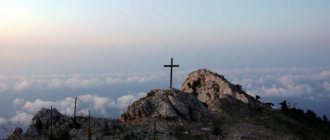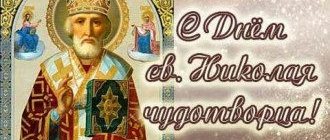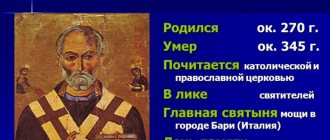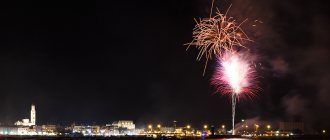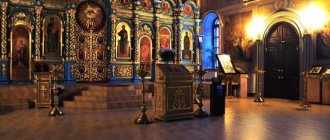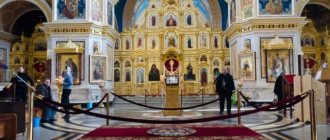Send your friends a ray of light from sunny Italy 
- 31
Shared
The city of Bari, the second most important city in southern Italy after Naples, is located on the heel of the Italian boot. Bari is the capital of the Apulia region, a major seaport and transport hub.
But if Bari had been just another port city, it would not have gained fame far beyond the borders of Italy and would not have become a place of pilgrimage for thousands of Christian believers. It is here that the relics of St. Nicholas the Wonderworker are located - one of the most revered saints among both Orthodox and Catholics.
Excursions in Bari and the surrounding area with Russian-speaking guides. To order =>, +7 910 476-34-33 (WhatsApp)
The history of the Basilica of St. Nicholas
The basilica was built specifically to store the relics of St. Nicholas transported to Bari. Initially, the relics were kept by the abbot of the Benedictine monastery Ilie, since Archbishop Urson was in Rome during the coronation of Pope Victor III.
However, after his return, the archbishop was unable to take possession of the important relic due to popular protests. Then Abbot Ilya was instructed to build a temple in which the relics of the saint would be kept.
They decided to build the basilica in the center of Bari. Initially, at the chosen site there was a Catapenal citadel, intended for holding official ceremonies.
Just two years later, the temple was consecrated by Pope Urban II (Urbanus PP. II), and the relics of the saint were placed in its crypt. However, construction of the building continued until 1105. The erected temple was damaged during the capture of the city by William I the Evil (Guglielmo I il Malo) in 1156, but four years later it was completely restored.
It is noteworthy that it was in the Basilica of St. Nicholas that Peter of Amiens preached the First Crusade in 1095.
During the reign of Emperor Friedrich II, the temple served as his court chapel. In 1799, many valuables were taken away by French troops.
Restoration work
In the period from 1928 to 1956, large-scale restoration work was carried out, during which a sarcophagus-reliquary was found hidden under the altar. It contained the relics of Nicholas the Wonderworker.
In 1951, the church passed to the Dominican Order on behalf of Pope Pius XII.
Today, anyone can visit the basilica - entry is absolutely free.
3. When do the annual celebrations in honor of the discovery of the relics take place in Bari?
The best time to visit Bari is from May 7 to 9 , when grandiose celebrations take place to mark the arrival of the relics of St. Nicholas in Bari.
The program of celebrations begins on the evening of May 7, when more than 400 participants in medieval costumes recreate the procession of the arrival of the relics into the city from St. George to the Basilica of St. Nicholas. Hundreds of candles, fiery torches and the incessant ringing of bells - an indescribable spectacle!
Also, during the three days of celebrations, you will have a unique opportunity to attend ceremonial services, see numerous concerts and fireworks.
Architecture of the Basilica of St. Nicholas
The building, built in the Romanesque style, looks impressive and massive. The façade features pilasters that divide the building into three parts. There are towers on both sides, which is why the building looks a bit like a castle.
Photo: Fedor Selivanov / Shutterstock.com
The central portal is decorated with exquisite carvings dedicated to the Eucharist. The upper part of the entrance is supported by columns mounted on bull sculptures. On the pediment you can see a winged sphinx.
Architecture and interior decoration[edit]
The basilica has three naves 39 meters long, a vaulted transept 31.5 meters long, the naves end with apses. The width of the central nave is 12.5 meters, the side ones - 6.5. From the outside, the apses are closed by straight walls with false arcades, which gives the temple a rectangular shape. The façade is divided into three parts by pilasters, on the sides there are two towers between which rises a central pillar. The entrance portal is decorated with carvings on the theme of the Eucharist (early 12th century). The portico of the portal is supported by columns resting on figures of bulls; in the lunette there is a relief with a solar chariot and a triumphant, symbolizing Jesus Christ. The pediment is topped with a winged sphinx.
The basilica is decorated with sculptural decoration, some of which (reliefs, capitals, cornices) were borrowed from more ancient Byzantine buildings. Around 1130, a throne and a ciborium (decorated with capitals and angels) were created; in the middle of the 12th century, an episcopal throne appeared, carved from a single piece of marble.
What to see inside
The temple has three naves ending in apses and a vaulted transept. The length of the latter is 31.5 meters, the naves are 39 meters long.
The outer side of the apse is covered by walls decorated with false arcades. Due to this, the space of the basilica appears rectangular.
Of particular artistic value is the pulpit in the Romanesque style, made at the end of the 11th century for Bishop Elias.
It is also worth paying attention to the magnificent mosaics laid out in the crypt and ciborium. The ceiling of the basilica is decorated with frescoes depicting scenes from the life of St. Nicholas. The frescoes were made by master Carl Rosa di Bitonto.
In addition, the temple houses the tomb of Bona Sforza, made of marble in the Renaissance style.
Crypt
Currently, the sarcophagus with the relics of St. Nicholas is located in the crypt of the basilica: it is a stone ossuary with a small hole designed to collect the world.
You cannot get too close to the sarcophagus - it is separated from the main space by a high grating (only pilgrim groups are allowed by prior arrangement).
Divine services
Every day the basilica holds services in various languages: on Thursdays in Russian. Orthodox believers have been granted the right to serve in the church crypt since 1969.
On Tuesdays and Thursdays, during services according to the Byzantine-Russian rite, the iron grate is opened and anyone can venerate the relics through a small window in the altar.
Museum
The Museum contains a huge number of scrolls, inscriptions, manuscripts, coats of arms, relics, cups, paintings and other valuable exhibits telling about the history of the city and the emergence of the basilica.
Here you can also see a collection of candlesticks created in the 12th century. They were donated to the basilica by King Charles I of Anjou.
Pilgrimage to the relics
Even after his repose, Saint Nicholas does not cease to care for his spiritual children, listening to their prayers and helping the sick and suffering. His prayers especially help children, the elderly, the poor and sick, merchants, sailors and travelers. The saint is revered in all faiths - Orthodox, Catholic, Muslim and even pagans.
Every year thousands of Russian pilgrims come to the city of Bari. Orthodox pilgrims have the right to perform services and prayers, and to contemplate the healing relics of the saint. Many travelers receive divine healing help from the great saint of God. The city of Bari can be proud to have such a shrine as the venerable icon of the saint and his relics.
How to get to the Basilica of St. Nicholas
The basilica is located in the Old Town - literally a 15-minute walk from the railway station and a few minutes from the seaport.
Exact address: Largo Abate Elia, 13.
Opening hours
The Basilica is open:
- from Monday to Saturday from 7.00 to 20.30;
- on Sunday from 7.00 to 22.00.
The museum is open daily from 10.30 to 18.00.
Ticket price
As of 2021, admission to the Basilica of St. Nicholas is free.
Check the information on the official website of the Basilica of St. Nicholas www.basilicasannicola.it.
Compound
The Bargrad courtyard consists of a beautiful temple, cozy buildings for receiving pilgrims, and a delightful large garden. This complex is a spiritual refuge for wanderers from Russia who visit the city in the hope of seeing the relics of the Saint.
The church and the courtyard were built with money collected throughout the Russian Empire. Since for a long time it was not possible to restore the church of St. Nicholas the Wonderworker in Myra Lycia, in 1911 the Bar-grad Committee was founded, which was patronized by the emperor himself. The task of the organization was to build an inn in Bari for travelers who flocked to the relics of the great wonderworker, as well as to build a church that would worthily reflect Orthodox art.
The celebration of the memory of the Wonderworker was established on December 19 and May 22, and that’s when the Bargrad gathering was held. The committee also received donations for the church from Princess Elizabeth Feodorovna in the amount of 3 thousand rubles, 10 thousand and an impressive amount of 246 thousand rubles were received from Emperor Nicholas II, which had previously been collected for the temple in Myra Lycia.
Construction project
In the spring of 1912, a project drawn up by the famous expert on ancient temple architecture A.V. Shchusev was already ready; in the personal archive of the architect, many working drawings, sketches, and various options for creating interior decoration, developed to the smallest detail, were preserved. However, due to the outbreak of the revolution, work was stopped, and the architectural monument is still located without the planned rich interior.
Italy and Russia planted their national flags at the construction site when construction began in 1913. In 1914, a shelter for pilgrims was already operating, and later it became temporary for refugees.
Russian emigrants became caretakers of church property abroad, seeking to preserve it for a revived Russia. But in the 30s of the 20th century, the temple became the property of the city municipality, against the will of the people who built it. The inn and church in Bari were abandoned for a while, and pilgrimages to the holy relics ceased.
The basilica lost almost all church property, valuable things such as a library, ancient utensils, and several dozen ancient icons disappeared without a trace. Magnificent decoration and ancient icons had already been prepared for the church, but due to the revolution it became impossible to deliver them from the Russian Empire. They were going to entrust the artist K. S. Petrov-Vodkin with painting the new temple, but he was unable to leave.
There were much fewer Russian believers in Italy after the revolution, and only thanks to the large Greek diaspora of the Orthodox faith, which especially revered St. Spyridon of Trimifunt (Salamin), the lower parish was consecrated in his honor in 1921.
Only in 2009, Italy transferred the Basilica to the Russian department, and now the temple has again become the property and pride of the Russian Church. Simultaneously with the creation of the temple complex in Bari, the construction of a new “Bargrad” temple in St. Petersburg was started. The Italian and Russian Bargrad churches are even similar to each other - single-domed, square, bell towers located above the western walls, gable roof, domes similar to a military helmet.
Iconostasis of the Metochion
The iconostasis is a canonical composition: the image of the Savior and the Mother of God icon with the Child - to the right of the Royal Gate, the image of St. Nicholas is to their left. From left to right in the iconostasis there are also icons of St. Queen Alexandra, St. healer and great martyr Panteleimon, St. Demetrius of Thessalonica, Great Martyr and Victorious George, Sergius of Radonezh, Alexander Nevsky, St. Seraphim of Sarov, wonderworker Spyridon of Trimythous. Further, the Basilica is decorated with icons of Saints Basil, Gregory and John, Holy Apostles Peter and Paul, Saint Equal-to-the-Apostles Prince Vladimir and Princess Olga.
In Apulia, the icon of the unmercenary saints Cosmas and Damian is very revered; it was placed on the north side above the entrance to the temple.
The icon of the Mother of God “The Sign” was painted by the artist A. A. Benois-Konsky together with his wife. Below the Mother of God icon is the Savior on the Throne. Among the shrines in the lower aisle there is an icon of St. Nicholas the Wonderworker, where his relics are kept. Since 1087, the holy relics of St. Nicholas have been carefully kept in the chapel of the Basilica. On the right side of the entrance to the upper temple of the basilica there is a great temple image.
Above the entrance to the basilica there is a mosaic icon depicting: the Savior, the Mother of God and St. Nicholas with the Gospel in hand, painted by the Italian artist Niccolo Colonna in 1967.
The impressive chandelier was made in Serbia using donations from Russian emigrants. Installed in 1998, it stands out noticeably against the background of the snow-white vault. In front of the architectural complex there is a sculpture of St. Nicholas, masterfully executed by the Russian sculptor V. M. Klykov.
Photo[edit]
- Basilica of St. Nicholas
- Basilica of St. Nicholas
- Basilica of St. Nicholas
- Basilica of St. Nicholas
- Basilica of St. Nicholas
- Basilica of St. Nicholas
- Basilica of St. Nicholas
- Basilica of St. Nicholas
- Basilica of St. Nicholas
- Basilica of St. Nicholas
- In the crypt of the Basilica of St. Nicholas
- In the crypt of the Basilica of St. Nicholas
- In the crypt of the Basilica of St. Nicholas
- In the crypt of the Basilica of St. Nicholas
- In the crypt of the Basilica of St. Nicholas
- In the crypt of the Basilica of St. Nicholas
- In the crypt of the Basilica of St. Nicholas
- In the crypt of the Basilica of St. Nicholas
- In the crypt of the Basilica of St. Nicholas
- In the crypt of the Basilica of St. Nicholas
- In the crypt of the Basilica of St. Nicholas
- In the crypt of the Basilica of St. Nicholas
- In the crypt of the Basilica of St. Nicholas
- In the upper church of the Basilica of St. Nicholas
- In the upper church of the Basilica of St. Nicholas
- In the upper church of the Basilica of St. Nicholas
- Chapel of Holy Relics in the upper church of the basilica
- Icon of St. Nicholas on the facade of the Basilica
- The relics of St. Nicholas hidden
Saint Cancer
The tomb of St. Nicholas is austere, like a pagan altar. The Holy Relics of the Saint (about 75 percent) are located below floor level and are covered on all sides with reinforced concrete blocks. The absence of the remaining bones of the skeleton is explained by the fact that the Barian sailors were in a hurry for fear of the arrival of the Saracens, and therefore took the largest bones. The missing part of the Holy Relics is located in various churches around the world, primarily in Venice.
ECCO IL VIDEO CHE MOSTRA LE RELIQUIE DI SAN NICOLA
How to get there[edit]
Directions:
From Bari train station go along via Sparano - Cattedrale - via Carmine - Arco San Nicola - Piazza San Nicola. Along the embankment in the direction of Porto - Arco San Nicola - Largo Urbano II - Piazza San Nicola.
Travel from Bar to Bari by ferry:
Ferries run to the Italian city of Bari from the Montenegrin city of Bar (route Bar - Bari - Bar). Transportation is carried out by the Montenegrin company Montenegro Lines; it has two ferries - Sveti Stefan and Sveti Stefan II. You can book on the Montenegro Lines website, by phone (+382 30)31-23-66 and (+382 30)30-34-69 or in person at the port of Bar (ticket office on the right right at the entrance). To make a reservation, you just need to indicate the first and last name of one passenger, the date of travel and which cabin you need. You can book round trip tickets. Passport details are entered before departure. If tickets are booked in advance, your reservation number will be dictated to you. With this number, passports and money, you need to arrive at the port two hours before departure. A double sleeping cabin costs from 58 to 70 euros, a four-berth cabin costs from 56 to 67 euros.
If you want to make a pilgrimage from Montenegrin Bar to Italian Bari as part of a Russian group, it makes sense to buy a tour package in Montenegro (trip packages are usually sold at most excursion bureaus, of which there are many in all resort towns of Montenegro) or while you are still in Russia. Such services are provided by some Russian travel agencies. The trip includes: a night on the ferry (there), a day in Italy (tour of Bari, the basilica, a trip by bus with a guide to the nearest picturesque places of Apulia, free time), a night on the ferry (back). Please note: currently, a visa to Montenegro from Russia is not needed if your stay is up to 30 days, while Italy is in Schengen, however, if you are traveling to Bari from Bar as part of a pilgrimage group on a package tour, then you do not need a Schengen visa - authorities Italy agreed to this as an exception for Russian pilgrims. All you need is a passport and a stamp confirming your stay in Montenegro.
Address:
Largo Abate Elia, 13, 70122, Bari
Tel.:
+39 080.57.37.111
Email:
Official site
Basilica of Bari
The crypt or underground church, located under the transverse nave of the basilica, was built earlier than other parts of the temple. The cross vault is supported by 26 columns, two of which are made of Numidian marble, two of coral chips, one of red marble, and the rest of Greek marble.
What to pray for before the relics of St. Nicholas of Myra
Knowing about the saint’s gift to heal from the most terrible illnesses, believers offer him prayers for miraculous deliverance from ailments. The holy elder invariably heeds sincere spiritual prayers, rewarding everyone according to his faith.
In addition, during his lifetime the saint was famous for his desire to find truth and justice. Without sparing himself, he fought against dishonest people, protecting the innocent. Knowing this, they turn to the Wonderworker with prayers for protection from spiteful critics and liars who seek to denigrate a person’s good name before people.
You can also turn to the saint with prayers for help in the most difficult, hopeless situations. And also that we always have our daily bread.
Finally, we should not forget that Nicholas the Wonderworker is the patron saint of children. Therefore, believers always turn to the saint with prayers for the protection of their children from troubles, misfortunes, illnesses and everything bad.
Shrines[edit]
- relics of St. Nicholas of Myra
- wooden shrine in which Barian sailors transported the relics of St. Nicholas
- fragments of white linen in which the relics of St. Nicholas in 1087
- thorn from the Savior's crown of thorns
- a piece of sponge that Roman soldiers filled with vinegar and brought to the lips of Christ
- cross with a particle of the Honest and Life-Giving Cross of the Lord
- particle of the relics of St. Thomas
- particle of the relics of St. Jacob Zebedee
- particle of the relics of St. Iakov Alfeeva
- particle of the relics of the martyr. Longinus Sotnik
- particle of the relics of the martyr. Sebastian of Milan
- particle of the relics of Sschmch. Blaise of Sevastia
- tooth equal Mary Magdalene
- particle of the relics of St. Gregory the Great
- particle of the relics of Sschmch. Vincent of Saragossa
Construction and restoration
For hundreds of years, strong fortress walls surrounded the Citadel of St. Nicholas. On three sides there were entrance gates from Via Palazzo, the Arch of Anjou and Via Vanese. The basilica itself is surrounded by three squares, which were connected to each other during restoration work carried out in the last century.
These works significantly changed the layout of the premises. Before the construction of the sea promenade in the 1930s, the sea blocked the eastern part of the complex. Thus, the main access to the front square was through the ancient Via Francigena, which today corresponds to the Strada of the Palazzo di Citta. This road was once an ancient route for pilgrims heading to the basilica to commemorate Saint Nicholas, and thus became a meeting point between East and West.
Abbot Ilya ordered the construction of a crypt, which was supposed to shelter the remains of the saint. Work began in 1087 and ended in 1089 with its consecration by Pope Urban II. Construction of the basilica continued during the time of Ilya's successor, Abbot Eustathius. Finally, on June 22, 1197, the Basilica was consecrated.
Until the end of the 19th century, the building was periodically subjected to changes that changed only its original appearance, but not its integrity. However, at the beginning of the 20th century, the season of the “Great Restorations” (1925–1934) was opened, which returned the basilica to its current appearance.
Watch the Basilica's Easter service in 2021:
